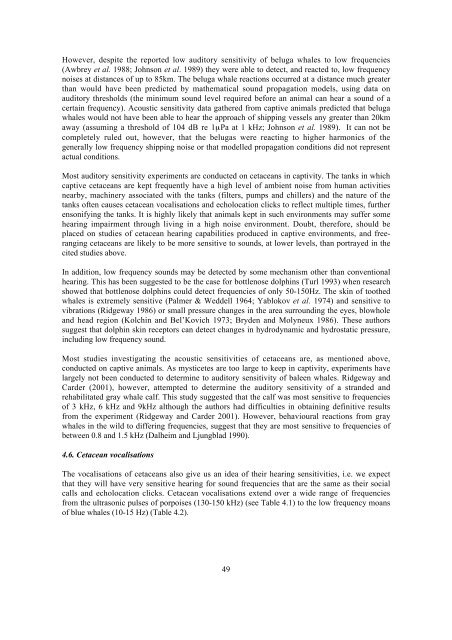Oceans of noise - Whale and Dolphin Conservation Society
Oceans of noise - Whale and Dolphin Conservation Society
Oceans of noise - Whale and Dolphin Conservation Society
Create successful ePaper yourself
Turn your PDF publications into a flip-book with our unique Google optimized e-Paper software.
However, despite the reported low auditory sensitivity <strong>of</strong> beluga whales to low frequencies<br />
(Awbrey et al. 1988; Johnson et al. 1989) they were able to detect, <strong>and</strong> reacted to, low frequency<br />
<strong>noise</strong>s at distances <strong>of</strong> up to 85km. The beluga whale reactions occurred at a distance much greater<br />
than would have been predicted by mathematical sound propagation models, using data on<br />
auditory thresholds (the minimum sound level required before an animal can hear a sound <strong>of</strong> a<br />
certain frequency). Acoustic sensitivity data gathered from captive animals predicted that beluga<br />
whales would not have been able to hear the approach <strong>of</strong> shipping vessels any greater than 20km<br />
away (assuming a threshold <strong>of</strong> 104 dB re 1µPa at 1 kHz; Johnson et al. 1989). It can not be<br />
completely ruled out, however, that the belugas were reacting to higher harmonics <strong>of</strong> the<br />
generally low frequency shipping <strong>noise</strong> or that modelled propagation conditions did not represent<br />
actual conditions.<br />
Most auditory sensitivity experiments are conducted on cetaceans in captivity. The tanks in which<br />
captive cetaceans are kept frequently have a high level <strong>of</strong> ambient <strong>noise</strong> from human activities<br />
nearby, machinery associated with the tanks (filters, pumps <strong>and</strong> chillers) <strong>and</strong> the nature <strong>of</strong> the<br />
tanks <strong>of</strong>ten causes cetacean vocalisations <strong>and</strong> echolocation clicks to reflect multiple times, further<br />
ensonifying the tanks. It is highly likely that animals kept in such environments may suffer some<br />
hearing impairment through living in a high <strong>noise</strong> environment. Doubt, therefore, should be<br />
placed on studies <strong>of</strong> cetacean hearing capabilities produced in captive environments, <strong>and</strong> freeranging<br />
cetaceans are likely to be more sensitive to sounds, at lower levels, than portrayed in the<br />
cited studies above.<br />
In addition, low frequency sounds may be detected by some mechanism other than conventional<br />
hearing. This has been suggested to be the case for bottlenose dolphins (Turl 1993) when research<br />
showed that bottlenose dolphins could detect frequencies <strong>of</strong> only 50-150Hz. The skin <strong>of</strong> toothed<br />
whales is extremely sensitive (Palmer & Weddell 1964; Yablokov et al. 1974) <strong>and</strong> sensitive to<br />
vibrations (Ridgeway 1986) or small pressure changes in the area surrounding the eyes, blowhole<br />
<strong>and</strong> head region (Kolchin <strong>and</strong> Bel’Kovich 1973; Bryden <strong>and</strong> Molyneux 1986). These authors<br />
suggest that dolphin skin receptors can detect changes in hydrodynamic <strong>and</strong> hydrostatic pressure,<br />
including low frequency sound.<br />
Most studies investigating the acoustic sensitivities <strong>of</strong> cetaceans are, as mentioned above,<br />
conducted on captive animals. As mysticetes are too large to keep in captivity, experiments have<br />
largely not been conducted to determine to auditory sensitivity <strong>of</strong> baleen whales. Ridgeway <strong>and</strong><br />
Carder (2001), however, attempted to determine the auditory sensitivity <strong>of</strong> a str<strong>and</strong>ed <strong>and</strong><br />
rehabilitated gray whale calf. This study suggested that the calf was most sensitive to frequencies<br />
<strong>of</strong> 3 kHz, 6 kHz <strong>and</strong> 9kHz although the authors had difficulties in obtaining definitive results<br />
from the experiment (Ridgeway <strong>and</strong> Carder 2001). However, behavioural reactions from gray<br />
whales in the wild to differing frequencies, suggest that they are most sensitive to frequencies <strong>of</strong><br />
between 0.8 <strong>and</strong> 1.5 kHz (Dalheim <strong>and</strong> Ljungblad 1990).<br />
4.6. Cetacean vocalisations<br />
The vocalisations <strong>of</strong> cetaceans also give us an idea <strong>of</strong> their hearing sensitivities, i.e. we expect<br />
that they will have very sensitive hearing for sound frequencies that are the same as their social<br />
calls <strong>and</strong> echolocation clicks. Cetacean vocalisations extend over a wide range <strong>of</strong> frequencies<br />
from the ultrasonic pulses <strong>of</strong> porpoises (130-150 kHz) (see Table 4.1) to the low frequency moans<br />
<strong>of</strong> blue whales (10-15 Hz) (Table 4.2).<br />
49

















